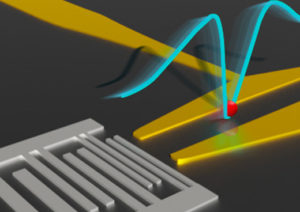- Home
- Institut Néel
- Research teams
- Technical Groups & Services
- Work at the Institut
- Partnerships
Circuits that transport single electrons one at a time could send quantum information between nodes of a quantum computer, but researchers have struggled with controlling the electron motion precisely enough. Now physicists have demonstrated improved control of single-electron transport using a focused sound wave, which carries the particle along a chip surface much as a solitary water wave propels a surfer. With further development, the researchers expect that the technique should be useful for engineering complex circuits for
use in quantum computing, or in controlling precision devices such as single photon sources.
Now an international team led by Christopher Bäuerle (Institut NEEL CNRS, France) & Shintaro Takada (AIST, Japon) have developed a method that uses an intense, localized sound pulse, rather than an extended wave.
Bäuerle compares the focused pulses to tidal bores—small tidal waves which often travel upstream in rivers on which people can surf over several kilometers. As he and his colleagues show, “acoustic tidal bores” can transport an electron accurately over long distances.
Published in the journal Physical Review X, September 7, 2022,
find the scientific result on the CNRS website here or on tweeter.

© C. Bauerle. The new “chirp” transducer (gray) generates an acoustic pulse (blue) with a single location to trap the electron (red). The transport through the channel (yellow) is extremely efficient.
